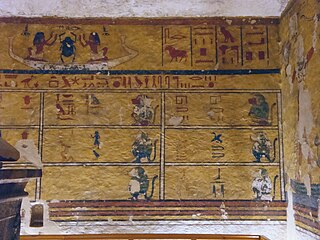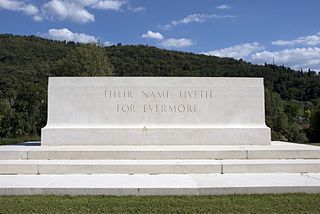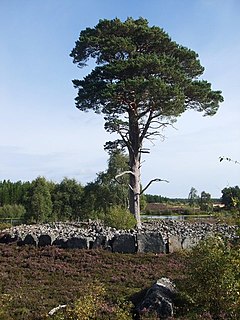
A passage grave or passage tomb consists of one or more burial chambers covered in earth or with stone, and having a narrow access passage made of large stones. These structures usually date from the Neolithic Age, and are found largely in Western Europe. When covered in earth, a passage grave is a type of burial mound which are found in various forms all over the world. When a passage grave is covered in stone, it is a type of cairn.

A tomb is a repository for the remains of the dead. It is generally any structurally enclosed interment space or burial chamber, of varying sizes. Placing a corpse into a tomb can be called immurement, and is a method of final disposition, as an alternative to cremation or burial.

The Commonwealth War Graves Commission (CWGC) is an intergovernmental organisation of six independent member states whose principal function is to mark, record and maintain the graves and places of commemoration of Commonwealth of Nations military service members who died in the two World Wars. The commission is also responsible for commemorating Commonwealth civilians who died as a result of enemy action during the Second World War. The commission was founded by Sir Fabian Ware and constituted through Royal Charter in 1917 as the Imperial War Graves Commission. The change to the present name took place in 1960.

A megalith is a large stone that has been used to construct a prehistoric structure or monument, either alone or together with other stones. There are over 35,000 in Europe alone, located widely from Sweden to the Mediterranean sea.

A headstone, tombstone, or gravestone is a stele or marker, usually stone, that is placed over a grave. It is traditional for burials in the Christian, Jewish, and Muslim religions, among others. In most cases, it has the deceased's name, date of birth, and date of death inscribed on it, along with a personal message, or prayer, but may contain pieces of funerary art, especially details in stone relief. In many parts of Europe, insetting a photograph of the deceased in a frame is very common.

A chamber tomb is a tomb for burial used in many different cultures. In the case of individual burials, the chamber is thought to signify a higher status for the interred than a simple grave. Built from rock or sometimes wood, the chambers could also serve as places for storage of the dead from one family or social group and were often used over long periods for multiple burials.

A gallery grave is a form of megalithic tomb built primarily during the Neolithic Age in Europe in which the main gallery of the tomb is entered without first passing through an antechamber or hallway. There are at least four major types of gallery grave, and they may be covered with an earthen mound or rock mound.

The Clava cairn is a type of Bronze Age circular chamber tomb cairn, named after the group of three cairns at Balnuaran of Clava, to the east of Inverness in Scotland. There are about 50 cairns of this type in an area round about Inverness. They fall into two sub-types, one typically consisting of a corbelled passage grave with a single burial chamber linked to the entrance by a short passage and covered with a cairn of stones, with the entrances oriented south west towards midwinter sunset. In the other sub-type an annular ring cairn encloses an apparently unroofed area with no formal means of access from the outside. In both sub-types a stone circle surrounds the whole tomb and a kerb often runs around the cairn. The heights of the standing stones vary in height so that the tallest fringe the entrance and the shortest are directly opposite it.

Grime's Graves is a large Neolithic flint mining complex in Norfolk, England. It lies 8 km (5.0 mi) north east from Brandon, Suffolk in the East of England. It was worked between c. 2600 and c. 2300 BC, although production may have continued well into the Bronze and Iron Ages owing to the low cost of flint compared with metals. Flint was much in demand for making polished stone axes in the Neolithic period. Much later, when flint had been replaced by metal tools, flint nodules were in demand for other uses, such as for building and as strikers for muskets.

Bedd Arthur is a possibly Neolithic hengiform monument megalithic site in the Preseli Hills in the Welsh county of Pembrokeshire. Thirteen upright stones and at least 2 fallen ones, each around 0.6 metres (2.0 ft) high form an oval horseshoe with similarities to the earliest form of Stonehenge.

The stone ship or ship setting was an early burial custom in Scandinavia, Northern Germany, and the Baltic states. The grave or cremation burial was surrounded by slabs or stones in the shape of a boat or ship. The ships vary in size and were erected from c. 1000 BCE to 1000 CE.

Bodowyr Burial Chamber is a Neolithic burial chamber made of a few large stacked stones in a farmer's field on the north Wales island of Anglesey. It is located at Bodowyr Farm, 1.25 mi (2.0 km) east of Llangaffo, off the B4419 road.

The Sieben Steinhäuser is a group of five dolmens on the Lüneburg Heath in the NATO training area of Bergen-Hohne, in the state of Lower Saxony in northern Germany. The stones are considered to be part of the funnelbeaker culture. The gravesite was granted protected cultural monument status in 1923.

The Stone of Remembrance is a standardised design for war memorials that was designed in 1917 by the British architect Sir Edwin Lutyens for the Imperial War Graves Commission (IWGC). It was designed to commemorate the dead of World War I, to be used in IWGC war cemeteries containing 1,000 or more graves, or at memorial sites commemorating more than 1,000 war dead. Hundreds were erected following World War I, and it has since been used in cemeteries containing the Commonwealth dead of World War II as well. It is intended to commemorate those "of all faiths and none", and has been described as one of Lutyens' "most important and powerful works", with a "brooding, sentinel-like presence wherever used".
Stone box graves were a method of burial used by Native Americans of the Mississippian culture in the Midwestern United States and the Southeastern United States. Their construction was especially common in the Cumberland River Basin, in settlements found around present-day Nashville, Tennessee.

Nordic megalith architecture is an ancient architectural style found in Northern Europe, especially Scandinavia and North Germany, that involves large slabs of stone arranged to form a structure. It emerged in northern Europe, predominantly between 3500 and 2800 BC. It was primarily a product of the Funnelbeaker culture. Between 1964 and 1974, Ewald Schuldt in Mecklenburg-Western Pomerania excavated over 100 sites of different types: simple dolmens, extended dolmens, passage graves, great dolmens, unchambered long barrows, and stone cists. In addition, there are polygonal dolmens and types that emerged later, for example, the Grabkiste and Röse. This nomenclature, which specifically derives from the German, is not used in Scandinavia where these sites are categorised by other, more general, terms, as dolmens, passage graves and stone cists.

Guardian stones are standing stones, always occurring in pairs, at the corners of rectangular and trapezoidally-arranged stone enclosures (hunebeds) around a dolmen. They are found especially in Scandinavia, in the German states of Mecklenburg-Vorpommern, Lower Saxony (Salongrab), Saxony-Anhalt and occasionally in Holstein. They are strikingly large stone blocks that form the corner post of enclosures or project above them like antae and lend the stone enclosures a monumental appearance.

The unchambered long barrowearthen long barrow, non-megalithic long barrow or non-megalithic mound, is a type of long barrow found across the British Isles, in a belt of land in Brittany, and in northern Europe as far east as the River Vistula. The term "unchambered" means that there is no stone chamber within the stone enclosure. In Great Britain they are often known as non-megalithic long barrows or unchambered long cairns.

A ring cairn is a circular or slightly oval, ring-shaped, low embankment, several metres wide and from 8 to 20 metres in diameter. It is made of stone and earth and was originally empty in the centre. In several cases the middle of the ring was later used. The low profile of these cairns is not always possible to make out without conducting excavations.

John Temple Graves was an American newspaper editor who is best known for being the vice presidential nominee of the Independence Party in the presidential election of 1908.





















